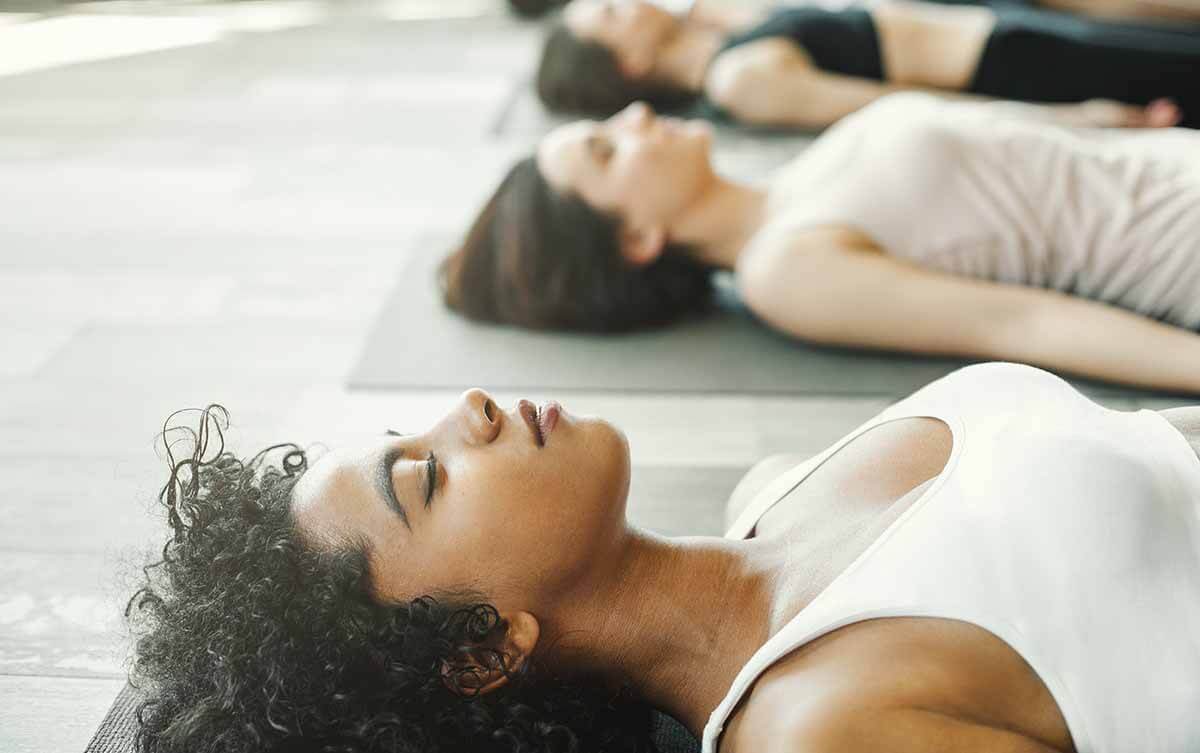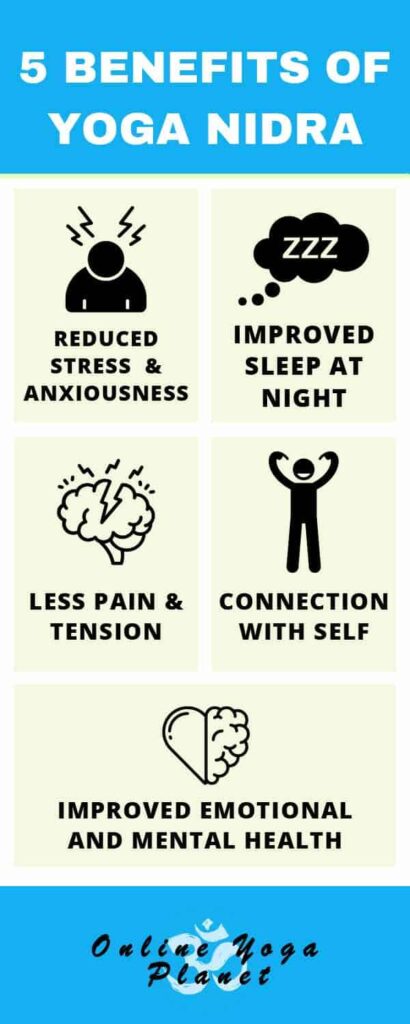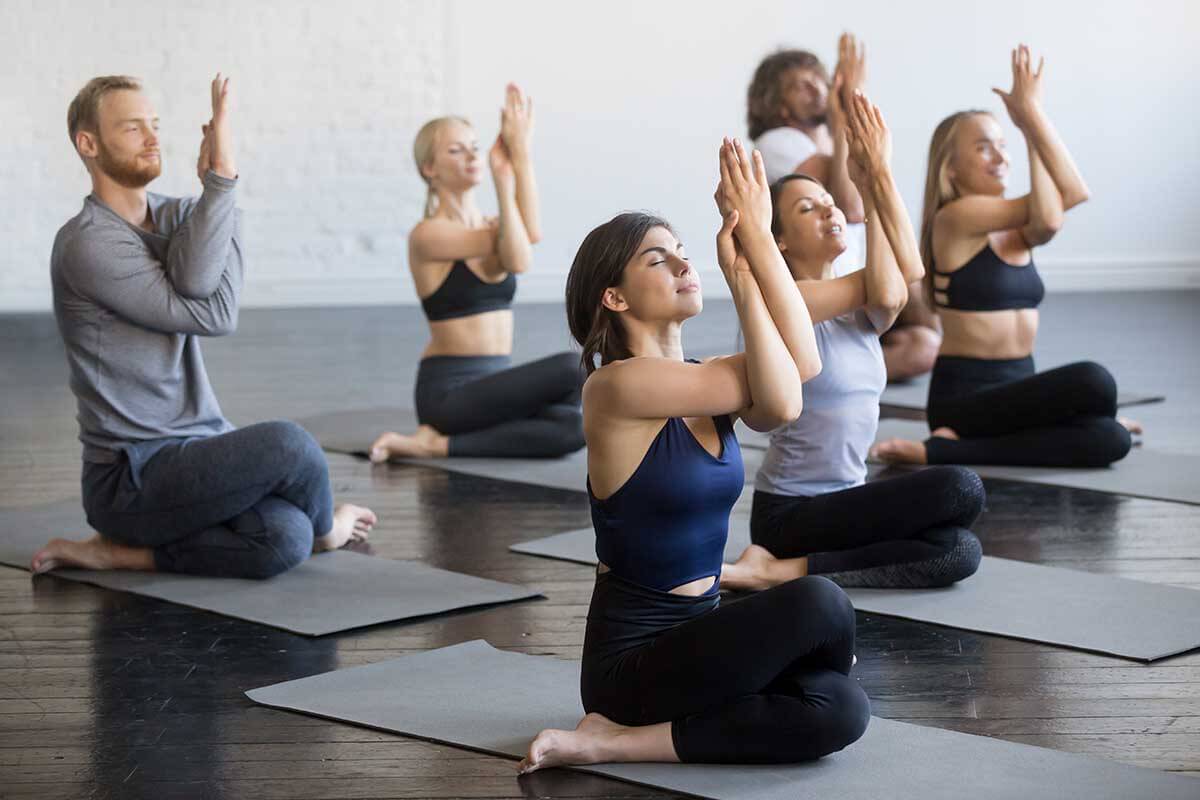
oga Nidra is an incredible meditation tool that is used to center your mind and body. Yoga Nidra, also known as yogic sleep, gives your body a chance to slow down and restore itself while you stay fully conscious.
Yoga Nidra, or yogic sleep, is a guided practice that brings a user to a state of consciousness between awake and asleep. Those who practice Yoga Nidra regularly can see physical and mental health benefits, including improved blood pressure, better sleep, and alleviating anxiety and stress.
Article Topics
5 Benefits of Yoga Nidra
Yoga Nidra has enormous benefits for your mental and physical health. Everyone will find the Yoga Nidra practice benefits them in different ways. Those who practice can expect benefits including:
- Reduced stress and anxiousness
- Improved sleep at night
- Less pain and tension
- Improved emotional and mental health
- Connection with self
Practices can generally see the benefits of yoga after they start doing 30-40 minute Yoga Nidra sessions daily.
 Reduce Stress and Anxiousness
Reduce Stress and Anxiousness
We deal with stress and anxiety every day. Work, school, families, and relationships can add unnecessary weight to our lives we don’t need to carry. One way you can help reduce any extra stress and anxiety is by regularly practicing Yoga Nidra.
Research states regular Yoga Nidra practice can help decrease excitement in your nervous system to subdue feelings of anxiety. The process of Yoga Nidra forces you to stop and focus on the inner self. Being able to ‘let go’ during practice gives a moment of peace and wholeness, shrinking the stresses of everyday life.
During Yoga Nidra, your body slows down. Your body that’s constantly in fight or flight from stress and anxiousness will be able to disarm and relax. As you get better with Yoga Nidra, you can recognize your body’s response when presented with anxiety and learn to avoid it altogether.
Stress can also affect your brain. When stress responses happen, your brain releases elevated cortisol levels, making it hard to recall memories and learn new things and increasing anxiety and depression.
75-90 percent of doctor office visits are due to stress-related illness. Stress and a weakened immune system can combine and create an array of physical symptoms, including headaches, fatigue, irritable bowel syndrome, skin issues, and obesity. It can also worsen problems like asthma, allergies, and autoimmune and inflammatory diseases.
Some studies show daily Yoga Nidra is an effective way to decrease physical and mental symptoms of anxiety. Yoga Nidra doesn’t precisely eradicate anxiety but absorbs it. The practice takes that anxiety and pushes it somewhere useful, like passion or excitement.
Yoga Nidra can be done anywhere, so take advantage of this fantastic meditation tool.
Improve Sleep
If you have difficulty falling asleep, Yoga Nidra is for you. Even though you don’t fall asleep during Yoga Nidra practice, using it as a tool before bedtime can help prepare your mind and body for a restful night.
Your body needs quality sleep, and Yoga Nidra can provide that. Sleep is essential to your body’s health, deep sleep being the most important. Average adults get around 1 to 2 hours of deep sleep per 8 hours at bedtime.
During Yoga Nidra, your mind becomes still. You focus on the breath and awareness of your body. Naturally, your heart rate will slow, the running thoughts in your mind will disappear, and you’ll be peaceful once the practice is complete. This state will allow you to easily fall into a quality night’s sleep, slowing your brainwaves and allowing you to stay asleep longer.
There have been multiple studies about the benefits of Yoga Nidra for those who have PTSD (Post-traumatic stress disorder), and it has been found to help improve sleep quality overall, especially in those who struggle with insomnia.
You can practice yoga Nidra any time during the day, but many find it beneficial at night before bed because of these benefits.
Less Pain and Tension
When your body feels stressed, your fight or flight is constantly activated. This stress response can overwork and weaken your immune system, not allowing your body to operate and function normally.
When your immune system weakens, you’re more susceptible to illness and inflammation. Yoga Nidra allows your body to decrease its stress response and gives it a chance to repair and restore itself, reducing inflammation. This inflammation could be in your sinuses, lungs, skin, etc.
Yoga Nidra can reduce pain perception, which is the pain you feel is less intense than usual. When you experience chronic pain, you can take what you learn during Yoga Nidra and focus your mind on another part of your body. Shifting your focus away from the pain can help it feel less severe.
There are many Yoga Nidra guides online specifically for chronic pain. It can even help improve tension in muscles or tightness. These guides will take you step-by-step to overcoming chronic pains by doing a simple body scan meditation and refocusing the mind.
Improved Emotional & Mental Health
Research about Yoga Nidra proves that it benefits us not only physically but also mentally. It reduces feelings of anxiety, depression and even helps boost dopamine levels.
A study done by Sara Lazar at Harvard University found that daily mindfulness meditation can impact the brain’s structure. This study found after eight weeks of meditating. There was an increase in the size of the hippocampus. The hippocampus is responsible for helping us learn new things and store memories. This is excellent news for those who practice Yoga Nidra daily!
If you experience a lot of negative thoughts or self-doubt, Yoga Nidra can help you, too. Over time, your negative thoughts will become minuscule as you learn to let them pass you by and no longer dwell on them. The practice literally rewires your brain to adapt and move your inner conversation to a more positive light.
Daily Yoga Nidra practice can help you become a more patient, understanding person. You learn to let unwanted thoughts pass by and exercise methods to control your emotions, like deep breathing and refocusing your mind. The practice gives you the tools you need to exercise compassion. All of these benefits result in improved mood and overall better well-being.
Connect with Self
As you go deeper into your Yoga Nidra journey, you’ll find it’s easier to get a clear look at who you are. It allows you to learn about your mind, get to know your body and recognize your thoughts.
You will become more kind to yourself. If you are often negatively self-taught, Yoga Nidra can open the door to speaking to yourself respectfully. Connecting and aligning yourself with the correct people and opportunities will be easier.
Through practice, you’ll find there becomes more space within your mind. You will be able to compartmentalize and not focus on unnecessary stress.
Yoga Nidra is a great way to get to know yourself when you’re engulfed in a project or just feeling disconnected. Checking in with your body in mind using meditation is a powerful tool. It connects you to the present, where you’re not stressing about the future or dwelling on the past. You’re living in the moment where you can sit back and appreciate life.
Yoga Nidra is a simple way to start improving your life. You can find a class near you that offers Yoga Nidra or hundreds of audio and video guides online. This meditation practice is an accessible way for everyone to align their body and mind, so start today for a healthier, happier life.
(To teach Yoga Nidra, check out this Yoga Nidra certification online!)

 Reduce Stress and Anxiousness
Reduce Stress and Anxiousness

